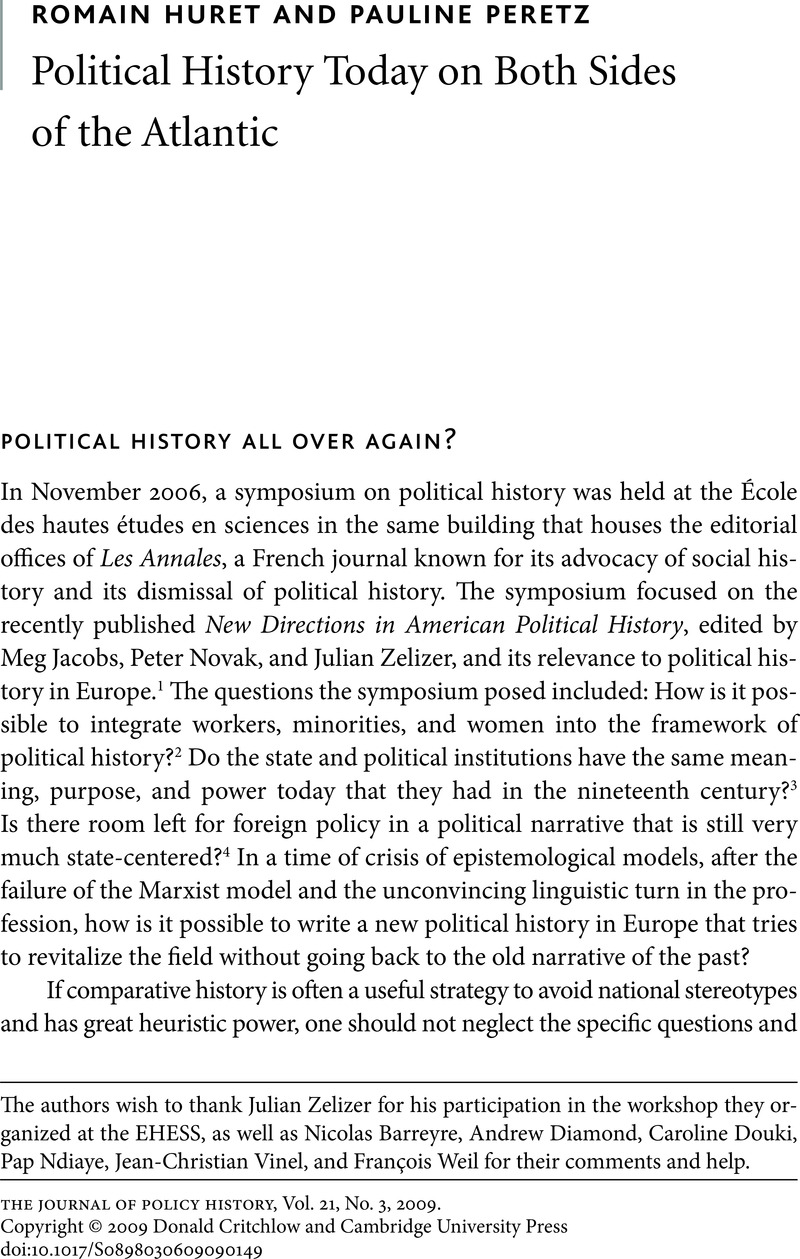No CrossRef data available.
Published online by Cambridge University Press: 01 July 2009

1. Jacobs, Meg, Novak, William, and Zelizer, Julian, eds., The Democratic Experiment: New Directions in American Political History (Princeton, 2003).Google Scholar
2. Baker, Paula, “The Midlife Crisis of the New Political History,” Journal of American History 86 (1999): 158–66.CrossRefGoogle Scholar
3. Balogh, Brian, A Government Out of Sight: The Mystery of National Authority in Nineteenth-Century America (Cambridge, 2009).CrossRefGoogle Scholar
4. For a general discussion, see McMahon, Robert J., “Toward a Pluralist Vision: The Study of American Foreign Relations as International History and National History,” in Explaining the History of American Foreign Relations, ed. Hogan, Michael J. and Paterson, Thomas G. (Cambridge, 2004)Google Scholar, and Hanhimäki, Jussi, “Bernath Lecture: Global Visions and Parochial Politics: The Persistent Dilemma of the ‘American Century,’” Diplomatic History 27, no. 4 (September 2003): 423–47.CrossRefGoogle Scholar And for an example of a very successful renewal of diplomatic history, see Dudziak, Mary, Cold War Civil Rights: Race and the Image of American Democracy (Princeton, 2000).Google Scholar
5. See, for example, Tilly, Charles, Big Structures, Large Processes, Huge Comparisons (New York, 1984)Google Scholar; Elliot, J. H., National and Comparative History (Oxford, 1991)Google Scholar; Bourdieu, Pierre, Charle, Christophe, Kaelble, Hartmut, and Kocka, Jürgen, “Dialogue sur l'histoire comparée, Actes de la recherche en sciences sociales, 106–7 (1995): 102–4.Google Scholar
6. Ernst Nolte's Der Europäische Bürgerkrieg, 1917–1945: Nationalsozialismus und Bolschewismus (1989) has ignited a huge controversy among both political and social historians. See Pavone, Claudio, “La Seconde Guerre mondiale: Europe et guerre civile européenne,” in Le siècle des guerres, ed. Guedj, François and Huret, Romain (Paris, 2004), 472–85Google Scholar, and Furet, François, “Le rapport dialectique fascisme-communisme,” Commentaire 20 (1997): 573–77.CrossRefGoogle Scholar
7. Solchany, Jean, «L'histoire vue d'en haut: Le XXe siècle allemand à l’échelle des grandes synthèses», Revue d'histoire moderne et contemporaine 53 (2006): 156–77CrossRefGoogle Scholar; Husson, Edouard, Comprendre Hitler et la Shoah: Les historiens de la République fédérale d'Allemagne et l'identité allemande depuis 1949 (Paris, 2000).Google Scholar
8. Prochasson, Christophe, L'Empire des émotions: Les Historiens dans la mêlée (Paris, 2008).Google Scholar
9. See in this issue Frederick C. Corney, “What Is to Be Done with Soviet Russia? The Politics of Proscription and Possibility.”
10. Offerlé, Michel and Rousso, Henri, eds., La fabrique interdisciplinaire: Histoire et science politique (Rennes, 2008).CrossRefGoogle Scholar
11. See, for example, Pierre Rosanvallon's work such as Le modèle politique français: La société civile contre le jacobinisme de 1789 à nos jours (Paris, 2004) and La démocratie inachevée: Histoire de la souveraineté du peuple en France (Paris, 2000); Ihl, Olivier, La fête républicaine (Paris, 1996)Google Scholar; Sabatier, Gérard, Dereymez, Jean-William, and Ihl, Olivier, Un cérémonial politique: Les voyages officiels des chefs d’état (Paris, 1998).Google Scholar
12. See, for example, Linz, Juan, Stepan, Alfred, Problems of Democratic Transition and Consolidation: Southern Europe, Latin America, and Post-Communist Europe (Baltimore, 1996)Google Scholar; Whitehead, Laurence, ed., The International Dimensions of Democratization: Europe and the Americas (Oxford, 1996)Google Scholar; Vanhanen, Tatu, The Process of Democratization: A Comparative Study of 147 States, 1980–1988 (New York, 1990).Google Scholar
13. Malia, Martin, “Why Amalrik Was Right,” Times Literary Supplement, 6 November 1992, 9.Google Scholar
14. For a review of the literature, see Gianfranco Pasquino's article in this issue.
15. For a review of the literature, see Paul Readman's article in the issue.
16. For Italy, see Rossi-Doria, Anna, Diventare cittadine. il voto alle donne in Italia (Florence, 1996)Google Scholar; for France, see, for example, Bard, Christine, Baudelot, Christian, and Mossuz-Lavau, Janine, eds., Quand les femmes s'en mêlent … Genre et pouvoir (Paris, 2004).Google Scholar
17. Sirinelli, Jean-François, Les Baby-Boomers: Une génération (1945–1969) (Paris, 2005).Google Scholar
18. See, for example, Grigor Suny, Ronald, “Toward a Social History of the October Revolution,” American Historical Review 88 (February 1983): 31–52CrossRefGoogle Scholar, Fitzpatrick, Sheila, The Russian Revolution, 1917–1932 (Oxford, 1982)Google Scholar, And for more recent work, see Rogers, Douglas, “Historical Anthropology Meets Soviet History,” Kritika: Explorations in Russian and Eurasian History 7 (2006): 633–49CrossRefGoogle Scholar; Edele, Mark, “Soviet Society, Social Structure, and Everyday Life: Major Frameworks Reconsidered,” Kritika: Explorations in Russian and Eurasian History 8 (2007): 349–73CrossRefGoogle Scholar; Depretto, Jean-Paul, “Stratification without Class,” Kritika: Explorations in Russian and Eurasian History 8 (2007): 375–88.CrossRefGoogle Scholar
19. See, for example, Lazar, Marc, ed., La gauche en Europe depuis 1945: Invariants et mutations du socialisme européen (Paris, 1996)Google Scholar. See Hanley, David, ed., Christian Democracy in Europe: A Comparative Perspective (London, 1994)Google Scholar, and Durand, Jean-Dominique, L'Europe de la démocratie chrétienne (Brussels, 1995)Google Scholar; Nora, Pierre, ed., Les lieux de mémoire, vol. 1, La République (Paris, 1984)Google Scholar; vol. 2, La Nation (Paris, 1986); vol. 3, Les France (Paris, 1992).
20. Sommier, Isabelle, La violence politique et son deuil: l'après 68 en France et en Italie (Rennes, 1998).CrossRefGoogle Scholar
21. François, Etienne and Schulze, Hagen, Deutsche Erinnerungsorte : Mémoires allemandes (Munich, 2001).Google Scholar
22. Isnenghi, Mario, I luoghi della memoria: Strutture ed eventi dell'Italia unita (Rome, 1997).Google Scholar
23. Mosse, George L., Fallen Soldiers: Reshaping the Memory of the World Wars (New York, 1991).Google Scholar
24. Hobsbawm, Eric, The Age of Extremes: The Short Twentieth Century, 1914–1991 (London, 1994).Google Scholar
25. Mazower, Mark, Dark Continent: Europe's Twentieth Century (London, 1998).Google Scholar
26. In the United States, see Jacobs, Novak, and Zelizer, eds, The Democratic Experiment; in France, see Prochasson, Christophe, L'Empire des émotions: Les Historiens dans la mêlée (Paris, 2008).Google Scholar
27. For the French case, see Boutier, Jean and Julia, Dominique, eds., Passés Recomposés: Champs et chantiers de l'histoire (Paris, 1995)Google Scholar; for the American crisis of political history, among many books devoted to the degradation of traditional standards of history in a postmodern academic world, see Appleby, Joyce, Hunt, L., and Jacob, M., Telling the Truth About History (New York, 1994)Google Scholar; Harlan, David, The Degradation of American History (Chicago, 1997).CrossRefGoogle Scholar